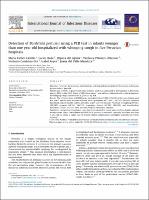| dc.contributor.author | Castillo, María Esther | |
| dc.contributor.author | Bada, Carlos | |
| dc.contributor.author | Del Águila, Olguita | |
| dc.contributor.author | Petrozzi-Helasvuo, Verónica | |
| dc.contributor.author | Casabona-Ore, Verónica | |
| dc.contributor.author | Reyes, Isabel | |
| dc.contributor.author | Del Valle-Mendoza, Juana | |
| dc.date.accessioned | 2019-04-16T14:44:46Z | |
| dc.date.available | 2019-04-16T14:44:46Z | |
| dc.date.issued | 2015 | |
| dc.identifier.citation | International Journal of Infectious Diseases. 2015; 41. | es_PE |
| dc.identifier.issn | 1201-9712 | |
| dc.identifier.uri | https://hdl.handle.net/20.500.12959/347 | |
| dc.description.abstract | Se realizó un estudio prospectivo transversal en cinco hospitales en Perú desde enero 2010 a julio 2012 para informar la incidencia, epidemiología y características clínicas de la Bordetella pertussis en niños peruanos menores de un año. Un total de 392 infantes menores de 1 año fueron admitidos con un diagnóstico clínico de tos ferina, probando la B. pertussis con el test PCR o técnica de Reacción en Cadena de la Polimerasa. | es_PE |
| dc.description.abstract | Objectives: To report the incidence, epidemiology, and clinical features of Bordetella pertussis in Peruvian
infants under 1 year old.
Patients and methods: A prospective cross-sectional study was conducted in five hospitals in Peru from
January 2010 to July 2012. A total of 392 infants under 1 year old were admitted with a clinical diagnosis
of whooping cough and tested for B. pertussis by PCR.
Results: The pertussis toxin and IS481 genes were detected in 39.54% (155/392) of the cases. Infants aged
less than 3 months were the most affected, with a prevalence of 73.55% (114/155). The most common
household contact was the mother, identified in 20% (31/155) of cases. Paroxysm of coughing (89.03%,
138/155), cyanosis (68.39%, 106/155), respiratory distress (67.09%, 104/155), and breastfeeding
difficulties (39.35%, 61/155) were the most frequent symptoms reported.
Conclusion: An increase in pertussis cases has been reported in recent years in Peru, despite national
immunization efforts. Surveillance with PCR for B. pertussis is essential, especially in infants less than
1 year old, in whom a higher rate of disease-related complications and higher mortality have been
reported | |
| dc.format | application/pdf | es_PE |
| dc.language.iso | eng | es_PE |
| dc.publisher | Oficina editorial de IJID | es_PE |
| dc.relation.uri | https://www.ijidonline.com/article/S1201-9712(15)00254-4/fulltext | |
| dc.rights | info:eu-repo/semantics/openAccess | es_PE |
| dc.rights.uri | https://creativecommons.org/licenses/by-nc-nd/4.0/ | es_PE |
| dc.source | Seguro Social de Salud (EsSalud) | es_PE |
| dc.source | Repositorio Institucional EsSalud | es_PE |
| dc.subject | Enfermedades infecciosas | es_PE |
| dc.subject | Tos Ferina | es_PE |
| dc.subject | Bordetella pertussis | es_PE |
| dc.subject | Reacción en Cadena de la Polimerasa | es_PE |
| dc.subject | Bordetella pertussis | |
| dc.subject | Whooping cough | |
| dc.subject | PCR | |
| dc.title | Detection of Bordetella pertussis using a PCR test in infants younger than one year old hospitalized with whooping cough in five Peruvian hospitals. | es_PE |
| dc.type | info:eu-repo/semantics/article | es_PE |
| dc.subject.ocde | https://purl.org/pe-repo/ocde/ford#3.03.08 | es_PE |
| dc.subject.ocde | https://purl.org/pe-repo/ocde/ford#3.03.09 | es_PE |
| dc.publisher.country | PE | es_PE |
| dc.identifier.doi | http://dx.doi.org/10.1016/j.ijid.2015.10.020 | |






